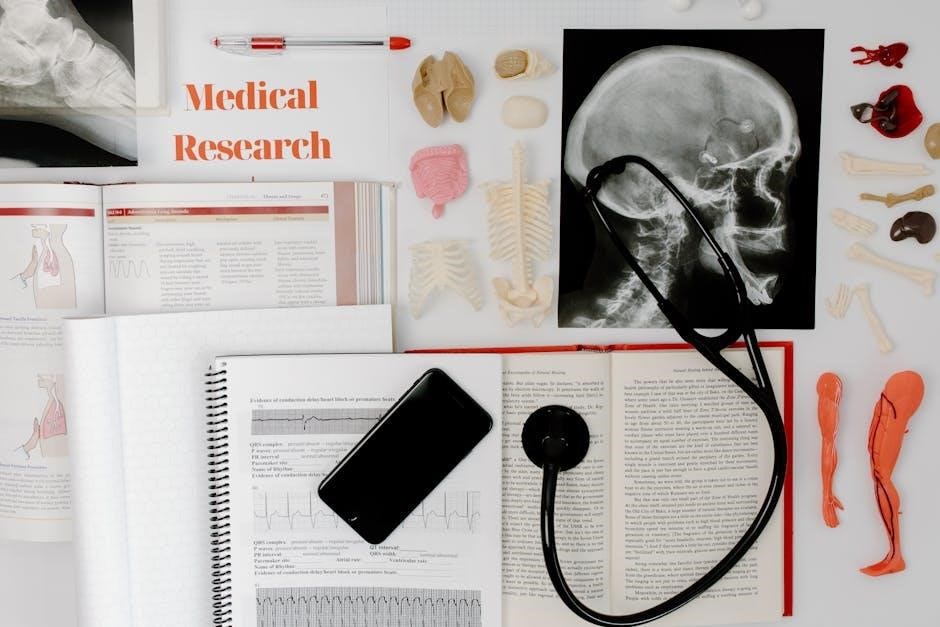The Modern Chemistry textbook serves as a comprehensive guide, offering detailed explanations and answer keys for various chemistry topics․ Its interactive PDF format and multimedia enhancements ensure an engaging and effective learning experience․

Evolution of Chemistry Textbooks
Chemistry textbooks have undergone significant transformations over the years, adapting to advancements in technology and educational methodologies․ From traditional print formats to interactive digital versions, modern textbooks now offer enhanced learning experiences․ The integration of multimedia elements, such as videos and simulations, has made complex concepts more accessible․ Answer keys and practice problems, as seen in resources like Modern Chemistry CHAPTER TESTS WITH ANSWER KEY, provide students with tools for self-assessment․ The shift toward digital access ensures that learners can engage with content anytime, anywhere․ Additionally, textbooks now incorporate real-world applications, fostering a deeper understanding of scientific principles․ This evolution reflects a commitment to improving student outcomes and preparing them for future challenges in chemistry․
Importance of Answer Keys in Learning
Answer keys play a vital role in the learning process, particularly in subjects like chemistry, where understanding concepts is crucial․ They provide students with the ability to verify their solutions and assess their grasp of the material․ By comparing their work to the correct answers, learners can identify errors and improve their problem-solving skills․ Modern Chemistry CHAPTER TESTS WITH ANSWER KEY and similar resources offer immediate feedback, fostering self-directed learning․ This approach not only builds confidence but also helps students refine their understanding of complex topics․ Additionally, answer keys promote accountability and critical thinking, as students can track their progress and address weak areas․ Their availability in PDF formats ensures accessibility, making them an indispensable tool for effective learning and preparation in chemistry education․

Key Features of the Modern Chemistry Textbook

The textbook offers an interactive PDF format, comprehensive topic coverage, and multimedia integration․ It provides chapter tests, answer keys, and practice problems, ensuring a well-rounded and engaging learning experience for students․
Interactive PDF Format
The interactive PDF format of the Modern Chemistry textbook enhances learning by providing easy navigation and multimedia integration․ Students can access chapter tests, answer keys, and practice problems directly within the document․ This format allows for interactive exercises, animations, and hyperlinks to additional resources, making complex concepts more engaging․ The ability to highlight, annotate, and search within the PDF ensures efficient studying․ Additionally, the interactive features cater to different learning styles, offering a flexible and dynamic approach to mastering chemistry․ The PDF format is also accessible on various devices, making it convenient for learners to study anytime, anywhere․ This modern approach to textbook design ensures that students stay engaged and have all the necessary tools at their fingertips to succeed in their chemistry studies․
Comprehensive Coverage of Topics
The Modern Chemistry textbook offers a thorough exploration of fundamental and advanced chemistry concepts․ It covers topics such as matter and change, chemical formulas, atomic structure, bonding, stoichiometry, thermochemistry, and electrochemistry․ Each chapter is designed to build a strong foundation, ensuring students understand the principles before progressing to more complex subjects․ The textbook also delves into specialized areas like nuclear chemistry and organic chemistry, providing a well-rounded education․ The inclusion of detailed answer keys and practice problems enhances comprehension, allowing learners to verify their understanding and refine their problem-solving skills․ This comprehensive approach ensures that students gain a deep and holistic knowledge of chemistry, preparing them for academic and professional challenges․ The textbook’s breadth and depth make it an invaluable resource for both classroom learning and independent study․
Multimedia Integration for Enhanced Learning
The Modern Chemistry textbook seamlessly incorporates multimedia elements to create an interactive and immersive learning experience․ Videos, animations, and interactive simulations help students visualize complex chemical processes, such as molecular interactions and reactions․ Audio explanations provide additional insights, catering to diverse learning styles․ The textbook also includes links to online resources, allowing learners to explore topics in greater depth․ Practice problems with embedded solutions guide students through challenging concepts, while interactive quizzes reinforce understanding․ This integration of multimedia tools enhances engagement and makes abstract chemistry concepts more accessible․ By leveraging technology, the textbook offers a dynamic approach to learning, ensuring that students stay motivated and achieve their academic goals effectively․ This feature-rich format sets the Modern Chemistry textbook apart as a cutting-edge educational resource․

Content Structure of the Textbook
The textbook is organized logically, covering chapters from Matter and Change to Nuclear Chemistry and Organic Chemistry, ensuring a comprehensive journey from basic to advanced chemistry concepts․
Chapter 1: Matter and Change
Chapter 1 introduces the fundamental concepts of chemistry, focusing on matter and change․ It explores the classification of matter, properties of substances, and the distinction between physical and chemical changes․ The chapter provides detailed explanations of states of matter, chemical properties, and conservation of mass․ Answer keys are included for practice problems, ensuring students can verify their understanding․ Topics such as elements, compounds, and mixtures are discussed, with a strong emphasis on the periodic table and its role in organizing chemical knowledge․ The chapter also includes interactive elements, such as multimedia enhancements, to facilitate deeper comprehension․ By mastering these foundational concepts, students build a solid base for advanced chemistry topics․ The PDF format allows easy access to diagrams, charts, and review questions, making learning engaging and efficient․ This chapter is essential for developing critical thinking and problem-solving skills in chemistry․
Chapter 2: Chemical Formulas and Equations
Chapter 2 delves into the essential skills of writing and interpreting chemical formulas and equations․ It explores the principles of chemical nomenclature, enabling students to identify and name compounds accurately․ The chapter provides detailed guidance on balancing chemical equations, emphasizing the law of conservation of mass․ Practice problems and answer keys are included to reinforce understanding․ Topics such as molecular formulas, empirical formulas, and reaction types are thoroughly covered․ The chapter also addresses common challenges, such as identifying reactants, products, and coefficients․ Multimedia enhancements in the PDF format offer interactive examples and step-by-step solutions, making complex concepts more accessible․ By mastering chemical formulas and equations, students gain a strong foundation for analyzing and predicting chemical reactions․ This chapter is crucial for developing problem-solving skills and preparing for advanced topics in chemistry․ The structured approach ensures clarity and comprehension․
Chapter 3: Atomic Structure and Periodicity
Chapter 3 explores the fundamental concepts of atomic structure and the periodic nature of elements․ It begins with the basic structure of atoms, including protons, neutrons, and electrons, and delves into electron configurations and quantum numbers․ The chapter explains the periodic trends, such as atomic radius, electronegativity, and ionization energy, highlighting how these properties vary across periods and groups․ Interactive PDF features provide visual representations of the periodic table and electron orbitals․ The chapter also covers the historical development of the periodic table and its significance in predicting element properties․ Practice problems and answer keys are included to test understanding, ensuring students can apply their knowledge to real-world scenarios․ This chapter equips students with a deep understanding of how elements are organized and how their properties relate to chemical behavior․ The content is supported by multimedia enhancements, making learning engaging and effective․
Chapter 4: Chemical Bonding and Molecular Structure
Chapter 4 delves into the principles of chemical bonding and molecular structure, essential for understanding how atoms interact․ It covers ionic and covalent bonds, explaining their formation and properties․ The chapter also explores molecular geometry, introducing theories like VSEPR (Valence Shell Electron Pair Repulsion) to predict shapes․ Key concepts include bond polarity, electronegativity, and the difference between polar and nonpolar molecules․ Interactive PDF resources provide visual aids, such as bond diagrams and 3D models, to enhance comprehension․ Practice problems with detailed solutions in the answer key help students master these concepts․ This chapter is crucial for grasping chemical behavior and reactions, offering a solid foundation for advanced topics․ The integration of multimedia enhancements makes learning engaging and accessible․ By understanding chemical bonding and molecular structure, students can better predict and explain chemical properties and reactions․ This chapter is a cornerstone of modern chemistry education․
Chapter 5: Stoichiometry and Chemical Reactions
Chapter 5 focuses on stoichiometry and chemical reactions, teaching students to quantify chemical changes․ It introduces mole ratios, limiting reagents, and percent yield, with practical examples․ The chapter explains how to balance equations and calculate reactant or product amounts․ Practice problems with detailed solutions in the answer key reinforce understanding․ Topics include types of chemical reactions (synthesis, decomposition, single replacement) and energy changes in reactions․ Interactive PDF resources and multimedia enhancements provide step-by-step guides and animations to visualize reaction processes․ Understanding stoichiometry is vital for predicting reaction outcomes and optimizing experiments․ This chapter equips students with essential skills for solving real-world chemistry problems, making it a foundational part of the curriculum․ By mastering these concepts, learners can confidently approach complex chemical scenarios and calculations․ The integration of multimedia tools ensures a dynamic and engaging learning experience․
Chapter 6: Thermochemistry and Thermodynamics
Chapter 6 delves into the principles of thermochemistry and thermodynamics, exploring energy changes in chemical reactions․ It covers key concepts such as enthalpy, entropy, and the laws of thermodynamics․ Students learn to calculate heat transfer using calorimetry and apply Hess’s Law for multi-step reactions․ The chapter also examines spontaneity and Gibbs free energy, essential for predicting reaction feasibility․ Practice problems with detailed solutions in the answer key help reinforce these concepts․ Interactive PDF resources and multimedia enhancements provide visualizations of thermodynamic processes․ This chapter is crucial for understanding how energy flows in chemical systems and how to analyze reaction efficiency․ By mastering thermochemistry and thermodynamics, students gain insights into real-world applications, such as energy storage and environmental processes․ The textbook’s structured approach ensures a deep understanding of these fundamental principles․
Chapter 7: Electrochemistry and Chemical Kinetics
Chapter 7 focuses on electrochemistry and chemical kinetics, introducing the flow of electrons in chemical reactions․ It explains oxidation-reduction (redox) reactions, galvanic cells, and electrolytic cells, highlighting their practical applications in batteries and electroplating․ The chapter also explores reaction rates, rate laws, and mechanisms, enabling students to analyze how concentration and temperature affect reactions․ Practice problems with solutions in the answer key help students master these concepts․ Interactive PDFs and multimedia resources provide simulations of electrochemical cells and reaction rate experiments․ This chapter equips students with a deeper understanding of energy transformation and reaction dynamics, crucial for advanced chemistry studies; By integrating theoretical knowledge with practical examples, the textbook prepares students for real-world applications in fields like energy storage and catalysis․ The comprehensive coverage ensures a solid foundation in these essential areas of modern chemistry․
Chapter 8: Acids, Bases, and Aqueous Chemistry
Chapter 8 delves into the properties and behaviors of acids, bases, and aqueous solutions, introducing fundamental concepts like pH, pOH, and the Arrhenius, Bronsted-Lowry, and Lewis theories․ It explores acid-base equilibria, solubility, and electrolysis, providing a clear understanding of aqueous chemistry․ The chapter includes practice problems with detailed solutions in the answer key, helping students grasp calculations involving pH, buffer solutions, and titration․ Interactive PDF resources offer simulations of acid-base titrations and electrolysis experiments․ Multimedia enhancements include videos explaining the behavior of strong and weak acids/bases․ This chapter is crucial for understanding chemical reactivity and prepares students for advanced topics in organic and analytical chemistry․ The integration of theoretical concepts with practical examples ensures a comprehensive learning experience․
Chapter 9: Nuclear Chemistry and Organic Chemistry
Chapter 9 explores nuclear chemistry and organic chemistry, providing a foundational understanding of nuclear reactions, fission, fusion, and their applications in medicine and energy․ It also introduces the structure, properties, and reactions of organic compounds, emphasizing hydrocarbons, functional groups, and reaction mechanisms․ The chapter includes detailed explanations of nuclear stability, radioactive decay, and the periodic table’s role in predicting nuclear behavior․ Practice problems with solutions in the answer key help students master calculations involving half-life and nuclear equations․ Multimedia resources offer interactive simulations of nuclear reactions and 3D models of organic molecules․ This chapter bridges the gap between inorganic and organic chemistry, preparing students for advanced topics in biochemistry and materials science․ The integration of theoretical concepts with practical examples ensures a deep understanding of both fields․

Study Resources and Aids
The textbook offers practice problems, laboratory exercises, and critical thinking exercises with detailed solutions․ These resources, along with answer keys and multimedia enhancements, provide comprehensive support for mastering chemistry concepts․
Practice Problems with Solutions
The Modern Chemistry textbook includes an extensive collection of practice problems, each accompanied by detailed step-by-step solutions․ These problems cover a wide range of topics, from basic chemical principles to advanced concepts; The solutions provide clear explanations, ensuring that students can understand and apply the concepts effectively․ Additionally, the problems are organized by chapter and topic, making it easy for students to focus on specific areas where they need improvement․ The inclusion of answer keys allows for self-assessment, helping students identify their strengths and weaknesses․ This resource is particularly useful for exam preparation, as it simulates real test scenarios․ The problems also incorporate real-world applications, making learning more engaging and relevant․ Overall, the practice problems with solutions are a valuable tool for reinforcing understanding and improving problem-solving skills in chemistry․ They are available in both printed and digital formats, including PDF, for convenient access․
Laboratory Exercises and Safety Guidelines
The Modern Chemistry textbook provides a comprehensive section dedicated to laboratory exercises and essential safety guidelines․ These exercises are designed to help students apply theoretical knowledge in practical scenarios, reinforcing their understanding of chemical concepts․ Each exercise includes detailed procedures, expected outcomes, and tips for conducting experiments safely․ The textbook emphasizes the importance of following proper safety protocols, such as wearing protective gear, handling chemicals cautiously, and understanding emergency procedures․ Clear diagrams and illustrations accompany the exercises, making complex procedures easier to follow․ Additionally, the textbook offers guidance on maintaining a clean and organized workspace, proper waste disposal, and the use of laboratory equipment․ By integrating these exercises, the textbook ensures that students gain hands-on experience while adhering to safety standards․ This section is particularly valuable for students preparing for lab sessions and for instructors designing experiments․ The exercises are also available in PDF format for easy access and reference․
Critical Thinking Exercises
The Modern Chemistry textbook includes a range of critical thinking exercises designed to challenge students and deepen their understanding of chemistry concepts․ These exercises require students to analyze complex problems, evaluate data, and develop well-reasoned solutions․ Topics span from stoichiometry and thermochemistry to electrochemistry and organic chemistry, ensuring a comprehensive approach․ Each exercise is accompanied by detailed explanations and answers, allowing students to assess their progress and identify areas for improvement․ The exercises are structured to promote logical reasoning and scientific inquiry, preparing students for real-world applications of chemistry․ Available in PDF format, these exercises are easily accessible and can be used for self-study or classroom discussions․ By engaging with these critical thinking challenges, students develop a stronger grasp of chemical principles and enhance their problem-solving skills․ This section is an invaluable resource for students aiming to excel in chemistry․

Problem Solving Strategies
The textbook offers effective problem-solving strategies, including step-by-step solution guides and tips to avoid common mistakes․ Interactive PDFs provide easy access to detailed explanations and practice problems, enhancing learning efficiency․
Approaches to Tackling Chemistry Problems
Mastering chemistry requires a structured approach․ Begin by identifying the type of problem, such as stoichiometry or thermodynamics․ Break it down into manageable steps, referencing textbook examples and key formulas․ Utilize answer keys to verify solutions and learn from mistakes․ Engage with practice problems to build proficiency․ Leverage interactive PDFs for visual aids like diagrams and videos, enhancing understanding․ Critical thinking exercises encourage analyzing “why” and “how” reactions occur, fostering deeper comprehension․ Regular review of concepts and application of problem-solving strategies ensures confidence in tackling complex chemistry challenges․ These methods, supported by the textbook’s resources, provide a robust framework for success in chemistry․
Common Mistakes and How to Avoid Them
Common mistakes in chemistry often stem from misinterpretation of formulas, incorrect stoichiometric calculations, and misunderstanding chemical concepts․ Students frequently overlook unit conversions, leading to errors in molarity and concentration problems․ Additionally, misidentifying reactants and products in chemical equations can result in incorrect solutions․ To avoid these pitfalls, thoroughly review basic principles and practice problem-solving systematically․ Verify answers using textbook-provided keys to identify and correct errors․ Regularly reviewing notes and engaging in critical thinking exercises can enhance conceptual clarity․ Utilize interactive tools, such as those in the Modern Chemistry textbook PDF, to visualize reactions and solidify understanding․ By addressing these common mistakes proactively, students can improve accuracy and confidence in their problem-solving skills․
Step-by-Step Solution Guides
The Modern Chemistry textbook provides detailed step-by-step solution guides for complex problems, ensuring clarity and understanding․ These guides break down each problem into manageable parts, offering clear explanations of concepts and calculations․ Students can follow along easily, reinforcing their grasp of fundamental principles․ The guides are particularly useful for topics like stoichiometry, thermodynamics, and electrochemistry, where systematic approaches are essential․ Each solution is accompanied by explanations of common pitfalls, helping students avoid mistakes․ Additionally, the guides include answer keys for practice problems, allowing learners to verify their work and identify areas for improvement․ The structured format and accessibility of these resources in PDF make them invaluable for self-study and exam preparation, enabling students to master chemistry with confidence and precision․ Regular use of these guides enhances problem-solving skills and fosters a deeper understanding of chemical concepts․

Preparation for Exams
The Modern Chemistry textbook offers chapter tests and practice problems with answer keys, aligning with exam formats․ Effective study strategies and time management tips are also provided, ensuring readiness for assessments․
Chapter Tests and Answer Keys
The Modern Chemistry textbook includes chapter tests with answer keys, providing students with a structured way to assess their understanding․ These tests cover key concepts and are aligned with exam formats, helping students familiarize themselves with question types․ The answer keys offer detailed solutions, enabling self-assessment and improvement․ Regular practice with these tests enhances problem-solving skills and reinforces learning․ Additionally, the inclusion of short-answer questions and multiple-choice formats mirrors real exam scenarios, preparing students for timed assessments․ The textbook also provides explanations for incorrect answers, helping students identify and address gaps in their knowledge․ By using these resources, students can systematically review and master each chapter, ensuring they are well-prepared for final exams․ The combination of tests and answer keys creates a comprehensive study tool that supports independent learning and exam success․
Effective Study Strategies
EFFECTIVE study strategies are crucial for mastering modern chemistry․ Start by creating a structured study schedule, allocating time for each topic based on its complexity․ Engage actively with the material by taking notes and summarizing key concepts in your own words․ Use the textbook’s interactive PDF format and multimedia enhancements to deepen understanding․ Break down complex topics into smaller sections and review them regularly to avoid cramming․ Leverage practice problems and simulations to apply theoretical knowledge practically․ Utilize the provided answer keys to check your work and identify areas needing improvement․ Collaborate with peers or join study groups to discuss challenging concepts․ Regularly review and organize your study materials, ensuring all resources are easily accessible․ By combining these strategies, you can optimize learning outcomes and build a strong foundation in chemistry․ Consistency and active engagement are key to achieving academic success․
Time Management Tips
Effective time management is essential for success in studying chemistry․ Start by prioritizing topics based on complexity and your understanding level․ Allocate specific time blocks for each concept, ensuring balanced coverage․ Break study sessions into manageable intervals, using techniques like the Pomodoro method to maintain focus․ Utilize the textbook’s answer keys to quickly identify areas needing improvement, saving time on unnecessary repetitions․ Set realistic goals for each study session and track progress to stay motivated․ Avoid procrastination by creating a detailed study schedule and sticking to it․ Dedicate time for regular reviews of notes and practice problems, reinforcing learning over time․ Balance study with leisure to maintain mental well-being and productivity․ By organizing your time wisely, you can efficiently master the material and prepare thoroughly for exams․ Consistency and smart planning are key to achieving academic success․

Technology Integration
The modern chemistry textbook offers digital access, interactive PDFs, and multimedia enhancements, providing students with flexible learning tools and resources to enhance their understanding of chemistry concepts anytime, anywhere․
Digital Access and Multimedia Enhancements

Digital access to the modern chemistry textbook provides students with interactive PDFs, allowing them to engage with content anytime, anywhere․ Multimedia enhancements such as videos, simulations, and 3D molecular models enrich the learning experience, making complex concepts more accessible․ These tools cater to diverse learning styles, ensuring a deeper understanding of chemistry principles․ The digital format also includes chapter tests and answer keys, enabling self-assessment and reinforcement of key topics․ The integration of multimedia elements, such as virtual labs and interactive exercises, fosters hands-on learning and critical thinking․ Additionally, the textbook’s digital platform supports cross-device compatibility, ensuring seamless access on computers, tablets, and smartphones․ These features collectively enhance student engagement, improve retention, and provide a modern, flexible approach to chemistry education, aligning with the demands of today’s tech-savvy learners․